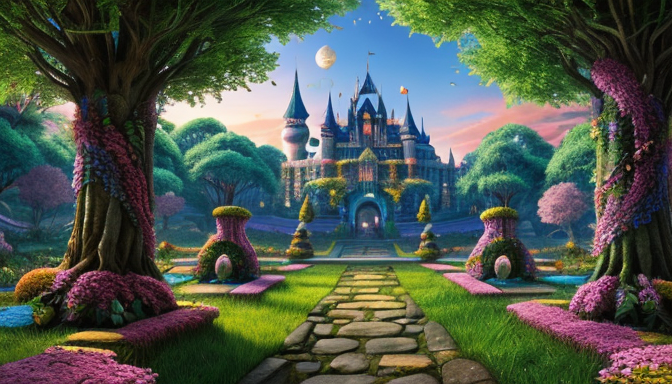Have you ever found yourself lost in a book, wandering through a world that feels as real as your own? Imaginary worlds are not just figments of our imagination; they are intricate tapestries woven with creativity and detail. Every corner of these realms is crafted with care, from the towering mountains to the sprawling cities, each element contributing to a rich narrative that captivates our minds.
One of the most fascinating aspects of world-building is the design of fantasy maps. These maps serve as the backbone of any fictional universe, guiding readers through vast landscapes and diverse cultures. Think of them as the treasure maps of our imagination, where each landmark tells a story. For instance, consider the following elements that enhance these maps:
- Landforms: Mountains, rivers, and forests create natural barriers and pathways that define the geography.
- Realms: Different kingdoms or territories can have unique characteristics, like climates and cultures, adding depth to the story.
- Kingdom Borders: Clearly defined borders can symbolize conflict or unity, shaping the relationships between different factions.
In essence, the art of world-building is about creating a space where readers can not only escape reality but also explore the boundaries of their imagination. These imaginary worlds challenge our perceptions, inviting us to question what is possible and inspiring us to dream bigger. So, the next time you dive into a fictional universe, take a moment to appreciate the detailed landscapes and the stories they tell.
The Art of World-Building
World-building is not just a tool; it’s an art form that breathes life into stories. Imagine stepping into a realm where every mountain has a tale to tell, and every river flows with history. Crafting an immersive world requires a blend of creativity and meticulous planning. One of the first steps is designing detailed fantasy maps. These maps serve as the backbone of your universe, guiding readers through the twists and turns of your narrative. They allow you to visualize the layout of lands, kingdoms, and the intricate relationships between them.
When creating your world, consider the landforms and their significance. Mountains can symbolize strength or isolation, while valleys might represent peace or hidden dangers. Each element contributes to the overall mood and tone of your story. For instance, a kingdom nestled in a lush valley might evoke feelings of tranquility, while a fortress perched atop a craggy peak could instill a sense of foreboding.
Furthermore, establishing realm borders is essential. These borders can signify not just geographical divisions, but also cultural and political differences. Think about how these distinctions shape the interactions between characters. Are there tensions at the borders? Are there trade routes that foster relationships? By answering these questions, you add depth and realism to your world, making it a place where readers can lose themselves.
Ultimately, the goal of world-building is to create a landscape that feels as real as the one outside your window. So, grab your pen, sketch those maps, and let your imagination soar!

The Influence of Imaginary Worlds on Culture
Imaginary worlds are not just playgrounds for our creativity; they are powerful mirrors reflecting the complexities of our society. Think about it: when we dive into a fictional universe, we’re not merely escaping reality; we’re exploring new perspectives that challenge our beliefs and expand our understanding. These worlds often serve as a canvas where authors paint their visions, allowing us to confront social issues, embrace diversity, and question the status quo.
For instance, consider how fantasy maps, landforms, and kingdom borders are meticulously crafted. Each element is designed to evoke feelings and convey messages. A sprawling kingdom might represent opportunity and ambition, while a treacherous mountain range could symbolize obstacles to overcome. This thoughtful world-building enriches the narrative, making it resonate deeply with audiences. It’s like walking through a gallery of ideas where each piece invites us to reflect on our own lives.
Moreover, imaginary worlds often influence real-world culture in significant ways. They inspire
- Fashion trends
- Language and slang
- Art and design
These elements seep into our everyday lives, shaping how we express ourselves and interact with others. The impact is profound; when we embrace these worlds, we not only entertain ourselves but also engage in a larger conversation about identity, ethics, and community.
Frequently Asked Questions
- What is world-building?
World-building is the creative process of constructing an imaginary universe, complete with its own rules, cultures, and histories. Think of it like setting the stage for a play, where every detail adds depth and richness to the story.
- Why are imaginary worlds important?
Imaginary worlds allow us to escape reality, explore new ideas, and reflect on our own lives. They can inspire creativity, provoke thought, and even provide commentary on societal issues, much like a mirror reflecting our own world.
- How do fictional universes influence culture?
Fictional universes shape cultural narratives by introducing new concepts and perspectives. They can influence trends, spark conversations, and even change how we view real-world events, akin to planting seeds of thought that grow into broader societal discussions.
- Can anyone create an imaginary world?
Absolutely! Anyone with a vivid imagination can create an imaginary world. It’s all about letting your creativity flow and building a setting that resonates with you and your audience.

Recent Comments